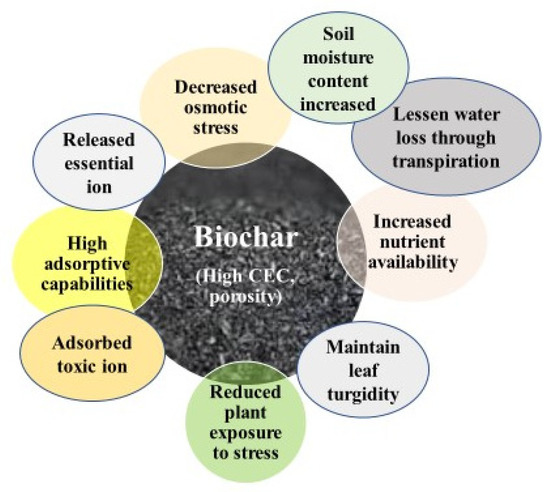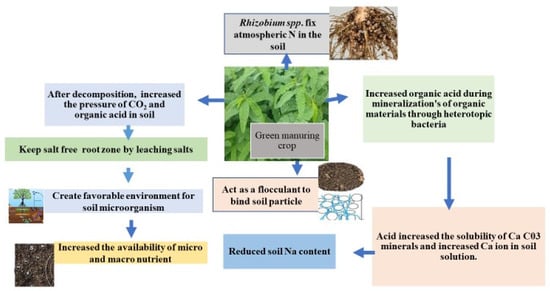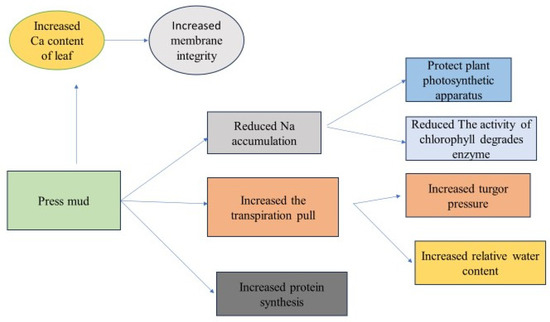
| Version | Summary | Created by | Modification | Content Size | Created at | Operation |
|---|---|---|---|---|---|---|
| 1 | Mirza Hasanuzzaman | -- | 2044 | 2024-03-16 08:23:01 | | | |
| 2 | Wendy Huang | Meta information modification | 2044 | 2024-03-19 08:15:45 | | |
Video Upload Options
Salinity and metal stress are significant abiotic factors that negatively influence plant growth and development. These factors lead to diminished agricultural yields on a global scale. Organic amendments have emerged as a potential solution for mitigating the adverse effects of salinity and metal stress on plants. When plants experience these stresses, they produce reactive oxygen species, which can impair protein synthesis and damage cellular membranes. Organic amendments, including biochar, vermicompost, green manure, and farmyard manure, have been shown to facilitate soil nitrogen uptake, an essential component for protein synthesis, and enhance various plant processes such as metabolism, protein accumulation, and antioxidant activities. Researchers have observed that the application of organic amendments improves plant stress tolerance, plant growth, and yield.
1. Introduction

2. Biochar

3. Compost
4. Vermicompost

5. Green Manure

6. Duckweed and Water Hyacinth
7. Poultry Manure
8. Farmyard Manure
9. Press Mud

10. Others
References
- Wang, M.; Zhao, S.; Wang, L.; Chen, S.; Li, S.; Lei, X.; Sun, X.; Qin, L. Salt stress-induced changes in microbial community structures and metabolic processes result in increased soil cadmium availability. Sci. Total Environ. 2021, 782, 147125.
- Nosek, M.; Kaczmarczyk, A.; Jędrzejczyk, R.J.; Supel, P.; Kaszycki, P.; Miszalski, Z. Expression of Genes Involved in Heavy Metal Trafficking in Plants Exposed to Salinity Stress and Elevated Cd Concentrations. Plants 2020, 9, 475.
- Ahmad, I.; Akhtar, M.J.; Zahir, Z.A.; Mitter, B. Organic amendments: Effects on cereals growth and cadmium remediation. Int. J. Sci. Technol. 2014, 12, 2919–2928.
- Alvarez, A.; Saez, J.M.; Davila Costa, J.S.; Colin, V.L.; Fuentes, M.S.; Cuozzo, S.A.; Benimeli, C.S.; Polti, M.A.; Amoroso, M.J. Actinobacteria: Current research and perspectives for bioremediation of pesticides and heavy metals. Chemosphere 2017, 166, 41–62.
- Askari, M.S.; Alamdari, P.; Chahardoli, S.; Afshari, A. Quantification of heavy metal pollution for environmental assessment of soil condition. Environ. Monit Assess 2020, 192, 162.
- Ali, I.; Yuan, P.; Ullah, S.; Iqbal, A.; Zhao, Q.; Liang, H.; Khan, A.; Zhang, H.; Wu, X.; Ei, S.; et al. Biochar amendment and nitrogen fertilizer contribute to the changes in soil properties and microbial communities in a paddy field. Front. Microbiol. 2022, 13, 834751.
- Mulugeta, A.; Getahun, G. Effect of organic amendments on soil fertility and environmental quality. J. Plant Sci. 2020, 8, 112–119.
- Hoque, M.N.; Imran, S.; Hannan, A.; Paul, N.C.; Mahamud, M.A.; Chakrobortty, J.; Sarker, P.; Irin, I.J.; Brestic, M.; Rhaman, M.S. Organic Amendments for Mitigation of Salinity Stress in Plants: A Review. Life 2022, 12, 1632.
- Saleem, A.; Ur Rahim, H.; Khan, U.; Irfan, M.; Akbar, W.A.; Akbar, Z.; Alatalo, J.M. Organic materials amendments can improve NPK availability and maize growth by reducing heavy metals stress in calcareous soil. Int. J. Environ. Sci. Technol. 2024, 21, 2533–2546.
- Ali, K.; Arif, M.; Shah, F.; Shehzad, A.; Munsif, F.; Mian, I.A.; Mian, A.A. Improvement in maize (Zea mays L.) growth and quality through integrated use of biochar. Pak. J. Bot. 2017, 49, 85–94.
- Shirale, A.O.; Kharche, V.K.; Wakode, R.R.; Meena, B.P.; Das, H.; Gore, R.P. Influence of gypsum and organic amendments on soil properties and crop productivity in degraded black soils of central India. Commun. Soil Sci. Plant. Anal. 2018, 49, 2418–2428.
- Agbede, T.M.; Oyewumi, A. Benefits of biochar, poultry manure and biochar–poultry manure for improvement of soil properties and sweet potato productivity in degraded tropical agricultural soils. Resour. Environ. Sustain. 2022, 27, 100051.
- Celestina, C.; Hunt, J.R.; Sale, P.W.; Franks, A.E. Attribution of crop yield responses to application of organic amendments: A critical review. Soil Till. Res. 2019, 186, 135–145.
- Jaiswal, B.; Singh, S.; Agrawal, S.B. Improvements in Soil Physical, Chemical and Biological Properties at Natural Saline and Non-Saline Sites Under Different Management Practices. Environ. Manag. 2022, 69, 1005–1019.
- Chahal, S.S.; Choudhary, O.P.; Mavi, M.S. Organic amendments decomposability influences microbial activity in saline soils. Arch. Agron. Soil Sci. 2017, 63, 1875–1888.
- Leogrande, R.; Vitti, C. Use of organic amendments to reclaim saline and sodic soils: A review. Arid. Land Res. Manag. 2019, 33, 1–21.
- Meers, E.; Ruttens, A.; Hopgood, M.; Lesage, E.; Tack, F.M. Potential of Brassic rapa, Cannabis sativa, Helianthus annuus and Zea mays for phytoextraction of heavy metals from calcareous dredged sediment derived soils. Chemosphere 2005, 61, 561–572.
- Nephali, L.; Piater, L.A.; Dubery, I.A.; Patterson, V.; Huyser, J.; Burgess, K.; Tugizimana, F. Biostimulants for Plant Growth and Mitigation of Abiotic Stresses: A Metabolomics Perspective. Metabolites 2020, 10, 505.
- Major, J.; Rondon, M.; Molina, D.; Riha, S.J.; Lehmann, J. Maize yield and nutrition during 4 years after biochar application to a Colombian savanna oxisol. Plant Soil. 2010, 333, 117–128.
- Bouqbis, L.; Daoud, S.; Koyro, H.W.; Kammann, C.I.; Ainlhout, L.F.Z.; Harrouni, M.C. Biochar from argan shells: Production and characterization. Int. J. Recyc. Org. Waste Agric. 2016, 5, 361–365.
- Rasa, K.; Heikkinen, J.; Hannula, M.; Arstila, K.; Kulju, S.; Hyväluoma, J. How and why does willow biochar increase a clay soil water retention capacity. Biomas. Bioener. 2018, 119, 346–353.
- Isimikalu, T.O.; Olaniyan, J.O.; Affinnih, K.O.; Abdulmumin, O.; Adede, A.C.; Jibril, A.H.; Atteh, E.; Yusuf, S. Rice husk biochar and inorganic fertilizer amendment combination improved the yield of upland rice in typical soils of Southern Guinea Savannah of Nigeria. Int. J. Recycl. Org. Waste Agric. 2022, 12, 412–456.
- Majumder, S.; Neogi, S.; Dutta, T.; Powel, M.A.; Banik, P. Th impact of biochar on soil carbon sequestration: Meta- analytical approach to evaluating environmental and economic advantages. J. Environ. Manag. 2019, 250, 109466.
- Mandal, S.; Pu, S.; Adhikari, S.; Ma, H.; Kim, D.H.; Bai, Y.; Hou, D. Progress and future prospects in biochar composites: Application and reflection in the soil environment. Crit. Rev. Environ. Sci. Technol. 2021, 51, 219–271.
- Yadav, V.; Karak, T.; Singh, S.; Singh, A.K.; Khare, P. Benefits of biochar over other organic amendments: Responses for plant productivity (Pelargonium graveolens L.) and nitrogen and phosphorus losses. Ind. Crops Prod. 2019, 131, 96–105.
- Dahlawi, S.; Naeem, A.; Rengel, Z.; Naidu, R. Biochar application for the remediation of salt-affected soils: Challenges and opportunities. Sci. Total Environ. 2018, 625, 320–335.
- Kocsis, T.; Kotroczó, Z.; Kardos, L.; Biró, B. Optimization of increasing biochar doses with soil–plant–microbial functioning and nutrient uptake of maize. Environ. Technol. Innov. 2020, 20, 101191.
- Alam, M.; Zawar, H.; Anwarzeb, K.; Muhammad, A.K.; Abdur, R.; Muhammad, A.; Muhammad, A.S.; Asim, M. The effects of organic amendments on heavy metals bioavailability in mine impacted soil and associated human health risk. Sci. Hort. 2020, 262, 109067.
- Gul, S.; Naz, A.; Fareed, I.; Irshad, M. Reducing Heavy Metals Extraction from Contaminated Soils Using Organic and Inorganic Amendments—A Review. Pol. J. Environ. Stud. 2015, 24, 1423–1426.
- Hannan, F.; Islam, F.; Huang, Q.; Farooq, M.A.; Ayyaz, A.; Fang, R.; Ali, B.; Xie, X.; Zhou, W. Interactive effects of biochar and mussel shell activated concoctions on immobilization of nickel and their amelioration on the growth of rapeseed in contaminated aged soil. Chemosphere 2021, 282, 130897.
- Lwin, C.S.; Seo, B.H.; Kim, H.U.; Owens, G.; Kim, K.R. Application of soil amendments to contaminated soils for heavy metal immobilization and improved soil quality—A critical review. Soil Sci. Plant Nutr. 2018, 64, 156–167.
- Elbagory, M. Reducing the Adverse Effects of Salt Stress by Utilizing Compost Tea and Effective Microorganisms to Enhance the Growth and Yield of Wheat (Triticum aestivum L.) Plants. Agronomy 2023, 13, 823.
- Guo, X.-X.; Liu, H.-T.; Zhang, J. The role of biochar in organic waste composting and soil improvement: A review. Waste Manag. 2020, 102, 884–899.
- Manirakiza, N.; Şeker, C. Effects of compost and biochar amendments on soil fertility and crop growth in a calcareous soil. J. Plant Nutr. 2020, 43, 3002–3019.
- Khatun, M.; Shuvo, M.A.R.; Salam, M.T.B.; Rahman, S.M.H. Effect of organic amendments on soil salinity and the growth of maize (Zea mays L.). Plant Sci. Today 2019, 6, 106–111.
- Oo, A.N.; Iwai, C.B.; Saenjan, P. Soil properties and maize growth in saline and nonsaline soils using cassava-industrial waste compost and vermicompost with and without earthworms. Land Degrad. Dev. 2015, 26, 300–310.
- Savy, D.; Cozzolino, V.; Vinci, G.; Verrillo, M.; Aliberti, A.; Maggio, A.; Barone, A.; Piccolo, A. Fertilization with compost mitigates salt stress in tomato by affecting plant metabolomics and nutritional profiles. Chem. Biol. Technol. Agric. 2022, 9, 104.
- Ahmed, K.; Sajib, A.I.; Naseem, A.R.; Qadir, G.; Nawaz, M.Q.; Khalid, M.; Warraich, I.A.; Arif, M. Use of hyacinth compost in salt-affected soils. Pak. J. Agric. Res. 2021, 33, 720–728.
- Cui, H.; Ou, Y.; Wang, L.; Yan, B.; Li, Y.; Bao, M. Critical passivation mechanisms on heavy metals during aerobic composting with different grain-size zeolite. J. Hazard. Mater. 2021, 406, 124313.
- Wang, W.; Man, Z.; Li, X.; Chen, R.; You, Z.; Pan, T.; Dai, X.; Xiao, H.; Liu, F. Response mechanism and rapid detection of phenotypic information in rice root under heavy metal stress. J. Hazard. Mater. 2023, 449, 131010.
- Tammam, A.D.; Shehata, M.R.A.M.; Pessarakli, M.; El-Aggan, W.H. Vermicompost and its role in alleviation of salt stress in plants—I. Impact of vermicompost on growth and nutrient uptake of salt-stressed plants. J. Plant. Nutr. 2023, 46, 1446–1457.
- He, H.; Tam, N.F.Y.; Yao, A.; Qiu, R.; Li, W.C.; Ye, Z. Growth and Cd uptake by rice (Oryza sativa) in acidic and Cd-contaminated paddy soils amended with steel slag. Chemosphere 2017, 9, 69.
- Wang, X.X.; Zhao, F.; Zhang, G.; Zhang, Y.; Yang, L. Vermicompost improves tomato yield and quality and the biochemical properties of soils with different tomato planting history in a greenhouse study. Front. Plant Sci. 2017, 8, 1978.
- Hafez, E.M.; Omara, A.E.; Alhumaydhi, F.A.; El-Esawi, M.A. Minimizing hazard impacts of soil salinity and water stress on wheat plants by soil application of vermicompost and biochar. Physiol. Plant. 2020, 172, 587–602.
- Liu, M.; Wang, C.; Wang, F.; Xie, Y. Vermicompost and humic fertilizer improve coastal saline soil by regulating soil aggregates and the bacterial community. Arch. Agron. Soil Sci. 2019, 65, 281–293.
- Chavez, E.; He, Z.L.; Stoffella, P.J.; Mylavarapu, R.; Li, Y.; Baligar, V.C. Evaluation of soil amendments as a remediation alternative for cadmium-contaminated soils under cacao plantations. Environ. Sci. Pollut. Res. 2016, 23, 17571–17580.
- Ciura, J.; Kruk, J. Phytohormones as targets for improving plant productivity and stress tolerance. J. Plant Physiol. 2018, 229, 32–40.
- Irin, I.J.; Biswas, P.K. Residual Effect of Green Manure on Soil Properties in Green Manure-Transplant Aman-Mustard Cropping Pattern. Indian J. Agric. Res. 2023, 57, 67–72.
- Irin, I.J.; Hoque, M.N.; Hannan, A.; Alam, M.M. Green manure for soil salinity reclamation—A comprehensive review. J. Agric. Food Envirn. 2022, 3, 5–14.
- Mubarak, A.R.; Nortclif, S. Calcium carbonate solubilization through H-proton release from some legumes grownin calcareous saline sodic soils. Land Degrad. Dev. 2010, 21, 24–31.
- Yazdanpanah, N. CO2 emission and structural characteristics of two calcareous soils amended with municipalsolid waste and plant residue. Solid Earth. 2016, 7, 105–114.
- Choudhary, O.P.; Ghuman, B.S.; Thuy, N.; Buresh, R.J. Effects of long-term use of sodic water irrigation, amendments and crop residues on soil properties and crop yields in rice–wheat cropping system in a calcareous soil. Field Crops Res. 2011, 121, 363–372.
- Parwar, S.K.; Kumbhar, G.A.; Dighe, P.K. Comparative study of crop residue, green manuring and gypsum on chemical properties and yield of cotton in salt affected oils of purna valley. J. Pharmacogn. Phytochem. 2020, 9, 442–445.
- Irin, I.J.; Biswas, P.K.; Ullah, M.J.; Roy, T.S. Effect of in situ green manuring crops and chemical fertilizer on yield of T. Aman rice and mustard. Asian J. Crop Soil Sci. Plant Nutr. 2020, 2, 68–79.
- Kim, K.R.; Owens, G.; Kwon, S.I. Influence of Indian mustard (Brassica juncea) on rhizosphere soil solution chemistry in long-term contaminated soils: A rhizobox study. J. Environ. Sci. 2010, 22, 98–105.
- Foucault, Y.; Lévêque, T.; Xiong, T.; Schreck, E.; Austruy, A.; Shahid, F.; Dumat, C. Green manure plants for remediation of soils polluted by metals and metalloids: Ecotoxicity and human bioavailability assessment. Chemosphere 2013, 93, 1430–1435.
- Bruning, B.; Van, L.R.; Broekman, R.; Vos, A.D.; González, A.P.; Rozema, Z. Growth and nitrogen fixation of legumes at increased salinity under field conditions: Implications for the use of green manures in saline environments. AoB Plants 2015, 7, 10.
- Dhir, B. Use of aquatic plants in removing heavy metals from wastewater. Int. J. Environ. Eng. 2010, 2, 185–201.
- Regni, L.; Del Buono, D.; Miras-Moreno, B.; Senizza, B.; Lucini, L.; Trevisan, M.; Morelli Venturi, D.; Costantino, F.; Proietti, P. Bio stimulant Effects of an Aqueous Extract of Duckweed (Lemna minor L.) on Physiological and Biochemical Traits in the Olive Tree. Agriculture 2021, 11, 1299.
- Zhou, Y.; Stepanenko, A.; Kishchenko, O.; Xu, J.; Borisjuk, N. Duckweeds for Phytoremediation of Polluted Water. Plants 2023, 12, 589.
- Leblebici, Z.; Aksoy, A.; Duman, F. Influence of salinity on the growth and heavy metal accumulation capacity of Spirodela polyrrhiza (Lemnaceae). Turk. J. Biol. 2011, 35, 215–220.
- TU, S.; Subash, A. Desalination of sea water using water hyacinth activated carbon. Int. Res. J. Eng. Technol. 2022, 9, 309–313.
- Guzmán, E.T.R.; Gutiérrez, L.R.R.; Allende, M.J.M.; Acevedo, Z.I.G.; Gutiérrez, M.T.O. Physicochemical properties of non-living water hyacinth (Eichhornia crassipes) and lesser duckweed (Lemna minor) and their influence on the As (V) adsorption processes. Chem. Ecol. 2013, 29, 459–475.
- Mockeviciene, I.; Repsiene, R.; Amaleviciute-Volunge, K.; Karcauskiene, D.; Slepetiene, A.; Lepane, V. Effect of long-term application of organic fertilizers on improving organic matter quality in acid soil. Arch. Agron. Soil Sci. 2022, 68, 1192–1204.
- Singh, A.; Agrawal, M. Management of heavy metal contaminated soil by using organic and inorganic fertilizers: Effect on plant performance. IIOAB J. 2011, 2, 22–30.
- Rani, N.; Singh, D.; Sikka, R. Effect of applied chromium and amendments on dry matter yield and uptake in maize-Indian mustard rotation in soils irrigated with sewage and tubewell waters. Agric. Res. J. 2018, 55, 677.
- Chattha, M.U.; Arif, W.; Khan, I.; Soufan, W.; Bilal Chattha, M.; Hassan, M.U.; Ullah, N.; Sabagh, A.E.; Qari, S.H. Mitigation of Cadmium Induced Oxidative Stress by Using Organic Amendments to Improve the Growth and Yield of Mash Beans . Agronomy 2021, 11, 2152.
- Kumar, S.; Meena, R.; Jinger, D.; Jatav, H.S.; Banjara, T. Use of press mud compost for improving crop productivity and soil health. Int. J. Chem. Stud. 2017, 5, 384–389.
- Nawaz, M.; Chattha, M.; Ahmad, R.; Munir, H.; Usman, M. Assessment of compost as nutrient supplement for spring planted sugarcane (Saccharum officinarum L.). J. Anim. Plant. Sci. 2017, 27, 283–293.
- Khan, I.; Muhammad, A.; Chattha, M.U.; Skalicky, M.; Bilal, C.M.; Ahsin, A.M. Mitigation of salinity induced oxidative damage, growth and yield reduction in fine rice by sugarcane press-mud application. Front. Plant Sci. 2022, 13, 865.
- Mahmood, T. Phytoextraction of heavy metals-the process and scope for remediation of contaminated soils. Soil Environ. 2010, 29, 91–109.
- Eissa, M.A. Impact of compost on metals Phyto stabilization potential of two halophytes species. Int. J. Phytoremediation 2015, 17, 662–668.
- Liu, M.; Tan, X.; Zheng, M.; Yu, D.; Lin, A.; Liu, J.; Wang, C.; Gao, Z.; Cui, J. Modified biochar/humic substance/fertiliser compound soil conditioner for highly efficient improvement of soil fertility and heavy metals remediation in acidic soils. J. Environ. Manag. 2023, 325, 116614.
- Navarro, C.; Díaz, M.; Villa-García, M.A. Physico-chemical characterization of steel slag. Study of its behavior under simulated environmental conditions. Environ. Sci. Technol. 2010, 44, 5383–5388.
- Kapoor, R.T.; Hasanuzzaman, M. Unlocking the potential of co-application of steel slag and biochar in mitigation of arsenic-induced oxidative stress by modulating antioxidant and glyoxalase system in Abelmoschus esculentus L. Chemosphere 2024, 17, 141232.
- Saki, P.; Mafigholami, R.; Takdastan, A. Removal of cadmium from industrial. wastewater by steel slag. Jundishapur J. Health Sci. 2013, 5, 23–34.




